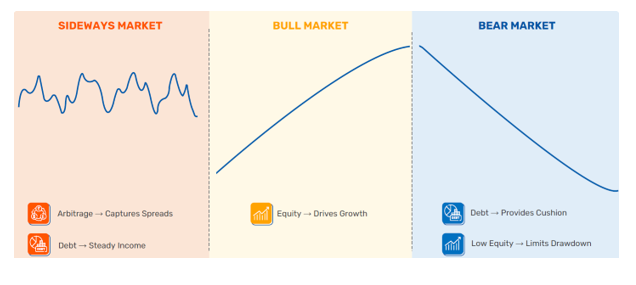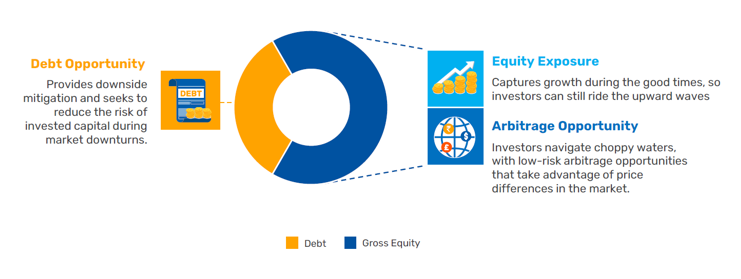Bajaj Finserv Equity Savings Fund: Balancing Stability and Growth

Current market context
The market has been volatile this year due to rapid geopolitical developments. Though the market has bounced back after cessation of hostilities in the Middle East, volatility due to global trade uncertainties, impact of tariffs / counter-tariffs, EU sanctions on Russian oil, etc, has dragged the market down again. As far as the debt market is concerned, bond prices have rallied after the RBI cut interest rates 3 times so far in CY 2025. However, bond yields have remained rangebound over the past month or so, due to pressure from US bond yields. In uncertain market conditions, asset allocation can provide stability to an investor's portfolio by balancing risks and returns.
Equity Savings Fund - A balanced approach
Investors are often faced with the dilemma of where to invest - traditional fixed income, which offers the comfort of low volatility but may fail to beat inflation or equity, which has the potential of providing capital appreciation but can be volatile. Equity Savings Fund can provide a middle path by providing a balance of stability through debt and arbitrage, and the growth potential of equities. The added advantage of Equity Savings Funds is the benefit of equity taxation. Bajaj Finserv MF has launched a new fund offer (NFO), Bajaj Finserv Equity Savings Fund. The NFO will open for subscription on 28th July 2025 and will close on 11th August 2025. In this article, we will review the Bajaj Finserv Equity Savings Fund.
What are Equity savings funds?
Equity savings funds are hybrid mutual fund schemes that have a minimum gross equity exposure of 65% and a minimum 10% exposure in debt. Equity savings funds can hedge their equity exposure to reduce their net equity risks.
How do equity savings funds work?
- Arbitrage: Arbitrage is a strategy to generate risk free profits by exploiting pricing mismatches of the same underlying asset in different market segments. A simple example of arbitrage is stock / future arbitrage, where you buy a stock in the cash market and simultaneously sell futures of the same underlying stock in the F&O market. The futures premium or spread between futures prices and spot price (share price in the cash market) is risk-free profit, irrespective of whether the share price moves up or down.
- Debt and Money Market: The fixed income / money market portion of the portfolio generates income and provides stability in volatile markets. Fund managers usually employ an accrual strategy or may take duration calls depending on their interest rate outlook.
- Active Equity: Equity savings funds take active (unhedged) exposure within specified allocation ranges. Fund managers may increase or decrease active equity exposure depending on market conditions. The proportion of active or unhedged equity, also known as Net Equity, and the hedged equity (arbitrage portion) determines the risk profile of individual equity savings funds. Different equity savings funds may have different risk profiles depending on their net equity exposures.
How do the Equity Savings funds work in Real markets?
The graphic below represents how the various components in the Equity Savings funds help to give risk-adjusted returns. The low equity ratio cushions during falling bear markets and gives equity growth during bull runs. During sideways markets, the arbitrage portion of the fund captures the spread while the Debt ensures a steady income.

Asset allocation of equity savings funds
- As per SEBI, minimum allocation to equity and arbitrage should be 65%. The fund manager may change allocations to equity and arbitrage based on the market outlook, but the overall exposure to equity and arbitrage should be 65% to 90%.
- These schemes are also required to mention their minimum hedged (arbitrage) and unhedged (equity) exposures in their Scheme Information Document.
- If the outlook is unfavourable, then the fund manager may increase allocation to arbitrage and reduce allocation to equity. If the outlook is favourable, then the fund manager may increase allocation to equity and reduce allocation to arbitrage.
- As per SEBI, minimum allocation to debt and money market instruments should be 10%. The maximum exposure to debt and money market will not exceed 35%.
- On average over a full investment cycle, average exposure to equity, arbitrage, and debt can be roughly one-third in each.
- Since equity savings funds have a minimum 65% exposure to equity and arbitrage (which involves equity-related securities), these schemes enjoy equity taxation.
Why invest in the Equity Savings Fund category?
- While options like FDs and PPF offer capital protection, their pre-tax returns have struggled to keep pace with inflation, leading to low or even negative real returns over time. Equity offers growth potential but with significant volatility and sharp drawdowns along the way. Equity savings funds offer a balanced approach, offering growth with stability.

- Tax advantage: Equity Savings Funds offer better long-term post-tax returns than debt investments, benefiting from a lower 12.5% LTCG tax versus income tax slab rates, making them a tax-efficient investment choice.

- Potential superior post-tax returns compared to traditional fixed income investments: A conservative investor in a high-income tax bracket can seek relatively better post-tax benefits from his investment in the Equity Savings Index. See the chart below that shows how the Nifty Equity Savings index has given alphas over traditional debt investment over various time periods.

Source: Bajaj Finserv AMC. Traditional Debt Investment returns are FD Rates of a top bank in India, and for equity savings, we have taken the average return of the NIFTY Equity Savings Index, average of daily rolling return. Source NSE data as on 30th June 2025. Past performance may or may not be sustained in future. Returns from traditional instruments are fixed; however, returns from Mutual Fund schemes are subject to market risk.
- Equity Savings category offers much lower drawdowns than pure equity funds, especially during market corrections
- For investors shifting out of equity or awaiting opportunities, Equity savings funds serve as a strategic, low-volatility, tax-optimized parking option.
- Unlike traditional debt instruments, Equity Savings options do not have any lock-in period and offer equity growth coupled with the stability of debt.
Bajaj Finserv Equity Savings Fund
The Bajaj Finserv Equity Savings Fund is an actively managed, hybrid strategy designed to participate in equity upside, reduce volatility, and offer tax efficiency. The fund is exposed to low volatility with an arbitrage cushion and equity taxation.
Asset Allocation of Bajaj Finserv Equity Savings Fund
- Net Equity: This is the unhedged part of the equity portfolio. Stocks are selected based on the GARP (Growth at Reasonable Price) strategy.
- Debt: This is the fixed income, which comprises of actively managed high-quality AAA/Sovereign papers.
- Arbitrage: This is hedged equity exposure, where the fund manager aims to capture spreads between futures and cash markets through an arbitrage strategy.
Why invest in Bajaj Finserv Equity Savings Fund?
- Measured Equity Exposure: Net equity in the fund is typically maintained between 10-40% during normal circumstances, which helps reduce portfolio volatility while still participating in upside. This delivers a relatively stable and reliable investment experience, even amid dynamic market conditions.
- Strategic Allocation to REITs & InvITs: This adds a new layer of diversification with potential for stable asset-backed income and offers investors access to alternative growth assets within a traditional mutual fund option.
- Equity taxation advantage: Unlike traditional fixed income investments, which are taxed as per the applicable income tax rate of the investor, Bajaj Finserv Equity Savings Fund will enjoy equity taxation. Short-term capital gains (holding period of less than 12 months) will be taxed at 20%, while long-term capital gains will be exempted from taxation for up to Rs 1.25 lakhs and taxed at 12.5% thereafter
- Flexibility with stability: Relatively low volatility of the fund makes it suitable for generating stable tax-efficient cash-flows through SWP.
- Serves a wide variety of investment needs: The fund is suitable for traditional fixed income investors who want to shift to other investment avenues for higher post-tax returns. It is also suitable for income planning needs, as well as for strategic asset allocation based on market timing and at the same time maintain relatively low volatility.
Consult your financial advisor or mutual fund distributor to understand if the Bajaj Finserv Equity Savings Fund is suitable for your investment needs.
Mutual Fund Investments are subject to market risk, read all scheme related documents carefully.
Bajaj Finserv Limited ('Bajaj Finserv', 'BFS' or 'the Company') is a Core Investment Company (CIC) under RBI Regulations 2020 and the holding company for the various financial services businesses under the Bajaj Group. Its vision is to provide financial solutions for retail and SME customers through their life cycle - asset acquisition and lifestyle enhancement through financing, asset protection through insurance, family protection through life and health insurance, healthcare needs for the family, savings & investment products, wealth management, retirement planning and annuities. BFS, through its various businesses, provides these solutions to over 100 million customers.
Investor Centre
Follow Bajaj Finserv
More About Bajaj Finserv
POST A QUERY









